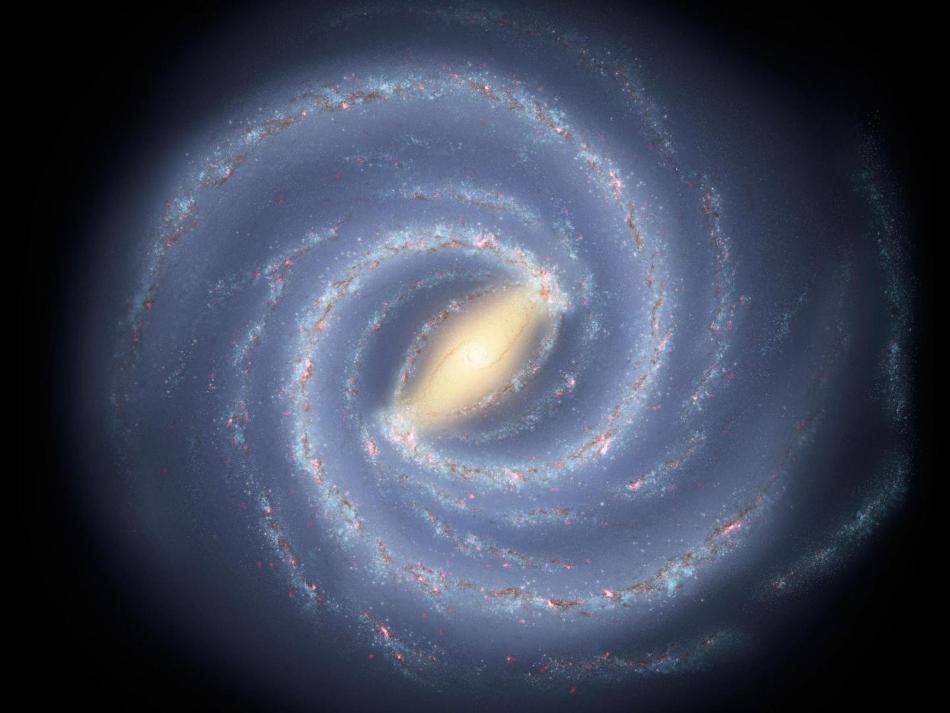Mar 6 2019
It is perplexing to think about how stars in galaxies, such as the Milky Way, rotate. The orbital speeds of stars are supposed to decrease as the distance from the galaxy center increases; however, in reality, the rotational speeds of stars in the middle and outer regions of galaxies are the same.
 The spiral structure of our galaxy, the Milky Way, in an artistic impression. (Image credit: NASA/JPL-Caltech)
The spiral structure of our galaxy, the Milky Way, in an artistic impression. (Image credit: NASA/JPL-Caltech)
This could be the result of the gravitational effect of matter that cannot be observed. Yet, despite the fact that researchers have been pursuing it for several decades, the occurrence of such “dark matter” is still to be proven definitively and there is no knowledge of what it could be made of. Bearing this in mind, physicists Dmitri Ryutov, Dmitry Budker, and Victor Flambaum have proposed that the galaxies’ rotational dynamics could be defined by other factors. They speculate that this could be due to the mass of photons—particles of light.
Professor Dmitri Ryutov—an expert in plasma physics who recently retired from the Lawrence Livermore National Laboratory in California, USA—was awarded the American Physical Society’s (APS) 2017 Maxwell Prize for Plasma Physics for his achievements in the area. In general, physicists credit Ryutov for finding the upper limit for a photon’s mass. Although this mass is nonzero, it is extremely small and often ignored while analyzing nuclear and atomic processes. However, the collaborative hypothesis of the researchers proposes that even a negligibly tiny mass of the photon could have an impact on large-scale astrophysical phenomena.
When they visited Johannes Gutenberg University Mainz (JGU), Ryutov, his host Professor Dmitry Budker of the Helmholtz Institute Mainz (HIM), and Professor Victor Flambaum, Fellow of the Gutenberg Research College of Mainz University, took a decision to take a closer look at the concept. They were intrigued by how the negligibly tiny mass of the photon could have an impact on huge galaxies. The mechanism at the center of the assumption by the physicists is a result of the so-called Maxwell-Proca equations. These would enable additional centripetal forces to be produced due to the electromagnetic stresses in a galaxy.
Are the effects as strong as those exerted by dark matter?
“The hypothetical effect we are investigating is not the result of increased gravity,” stated Dmitry Budker. This effect might appear concurrently with the presumed effect of dark matter. Under specific conditions, it may even completely avoid the need to elicit dark matter as a factor while interpreting rotation curves. Rotation curves explain the link between the orbital speeds of a galaxy’s stars and their radial distance from the center of the galaxy.
By assuming a certain photon mass, much smaller than the current upper limit, we can show that this mass would be sufficient to generate additional forces in a galaxy and that these forces would be roughly large enough to explain the rotation curves. This conclusion is extremely exciting.
Dmitry Budker, Professor, Helmholtz Institute Mainz
The physicists even took a step in advance and explored the formation of protostars. They found that their proposal has other implications. It estimates that long-lived, comparatively lightweight stars, like our sun, would have extremely elliptical orbits. “Actual observations clearly don’t agree with this prediction, meaning our theory can’t explain everything.” Thus, proca-force effects could only be accountable for certain anomalies in the rotation curves.
We don’t currently consider photon mass to be the solution to the rotation-curve problem. But it could be part of the solution. However, we need to keep an open mind as long as we do not actually know what dark matter is.
Dmitry Budker, Professor, Helmholtz Institute Mainz